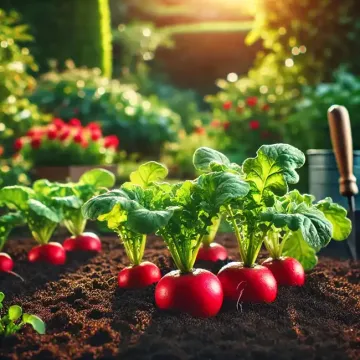Health Benefits of Radishes
Radishes are not only a tasty addition to meals but also packed with health benefits. They are low in calories and rich in vitamins, particularly vitamin C, which boosts the immune system. Radishes also contain fiber, potassium, and antioxidants that support heart health, aid in digestion, and help detoxify the body.
Types of Radishes
There are many types of radishes, each offering unique flavors and textures. Some of the most popular include:
- Cherry Belle: The classic red, round radish often found in grocery stores. It matures quickly and has a mild flavor.
- French Breakfast: An elongated radish with a pink body and white tip, known for its delicate taste.
- Watermelon Radish: This variety has a pale green exterior with a bright pink interior, resembling a watermelon, and offers a milder taste.
- Daikon: A large, white radish commonly used in Asian cuisine, offering a milder flavor and crunchy texture.
When and Where to Plant Radishes
Radishes thrive in cool weather, making them an ideal crop for spring and fall. They prefer full sun but can tolerate partial shade, especially in warmer climates. Choose a location with well-drained, loose soil to allow the roots to expand easily.
- Spring Planting: Plant radish seeds 4-6 weeks before the last expected frost date.
- Fall Planting: Sow seeds 4-6 weeks before the first expected frost date in autumn.
Radishes are perfect for succession planting, meaning you can sow seeds every 7-10 days for a continuous harvest.
How to Plant Radishes
Radishes are direct-seeded into the garden because they do not transplant well. Follow these simple steps to plant them:
- Prepare the Soil: Loosen the soil to a depth of about 6 inches, removing any rocks or debris. Radishes prefer slightly acidic to neutral soil (pH 6.0-7.0).
- Sow Seeds: Plant seeds about ½ inch deep and 1 inch apart in rows spaced 6-12 inches apart.
- Water: After planting, water the seeds gently but thoroughly. Keep the soil consistently moist to ensure even germination.
Growing Tips for Radishes
- Thinning: Once seedlings are about 1-2 inches tall, thin them to about 2 inches apart. Crowded radishes will not develop properly, so this step is crucial for a good harvest.
- Watering: Radishes need consistent moisture. Water regularly, especially during dry periods, but avoid waterlogging the soil.
- Mulching: Mulch around the radishes to retain moisture and suppress weeds.
Common Pests and Diseases
Radishes are relatively pest-resistant but can be affected by a few common issues:
- Flea Beetles: These small black beetles chew tiny holes in the leaves, which can stress young plants. Use row covers to protect seedlings.
- Root Maggots: These pests can tunnel into the radish roots, making them inedible. Rotate crops and avoid planting radishes in the same spot year after year to reduce the risk of infestation.
- Downy Mildew: This fungal disease affects the leaves, causing yellow spots and fuzzy growth. Ensure good air circulation and avoid overhead watering to prevent it.
Harvesting Radishes
Radishes mature quickly, often within 3-4 weeks of planting. Harvest them when the roots are about 1 inch in diameter (depending on the variety). Waiting too long to harvest can result in tough, woody roots. Simply pull the radishes from the soil by grasping the foliage at the base and gently tugging upward.
Storing Radishes
After harvesting, cut off the tops and store radishes in the refrigerator. They will stay fresh for up to two weeks when stored properly. Radishes can also be pickled for long-term storage and added flavor.
Culinary Uses for Radishes
Radishes are incredibly versatile in the kitchen. Here are some ways to enjoy them:
- Raw: Slice radishes for salads, sandwiches, or as a crunchy snack.
- Pickled: Quick-pickle radishes for a tangy addition to tacos, burgers, and salads.
- Roasted: Roasting radishes mellows their peppery flavor, making them a delicious side dish.
- Sautéed: Lightly sauté radish greens with garlic and olive oil for a nutritious side.
Radishes are a delightful addition to any home garden, offering quick rewards and a burst of flavor in the kitchen. With minimal care, you can enjoy fresh radishes throughout the growing season. Whether you’re looking for a simple, beginner-friendly crop or a way to add variety to your garden, radishes are an excellent choice. Happy gardening!

